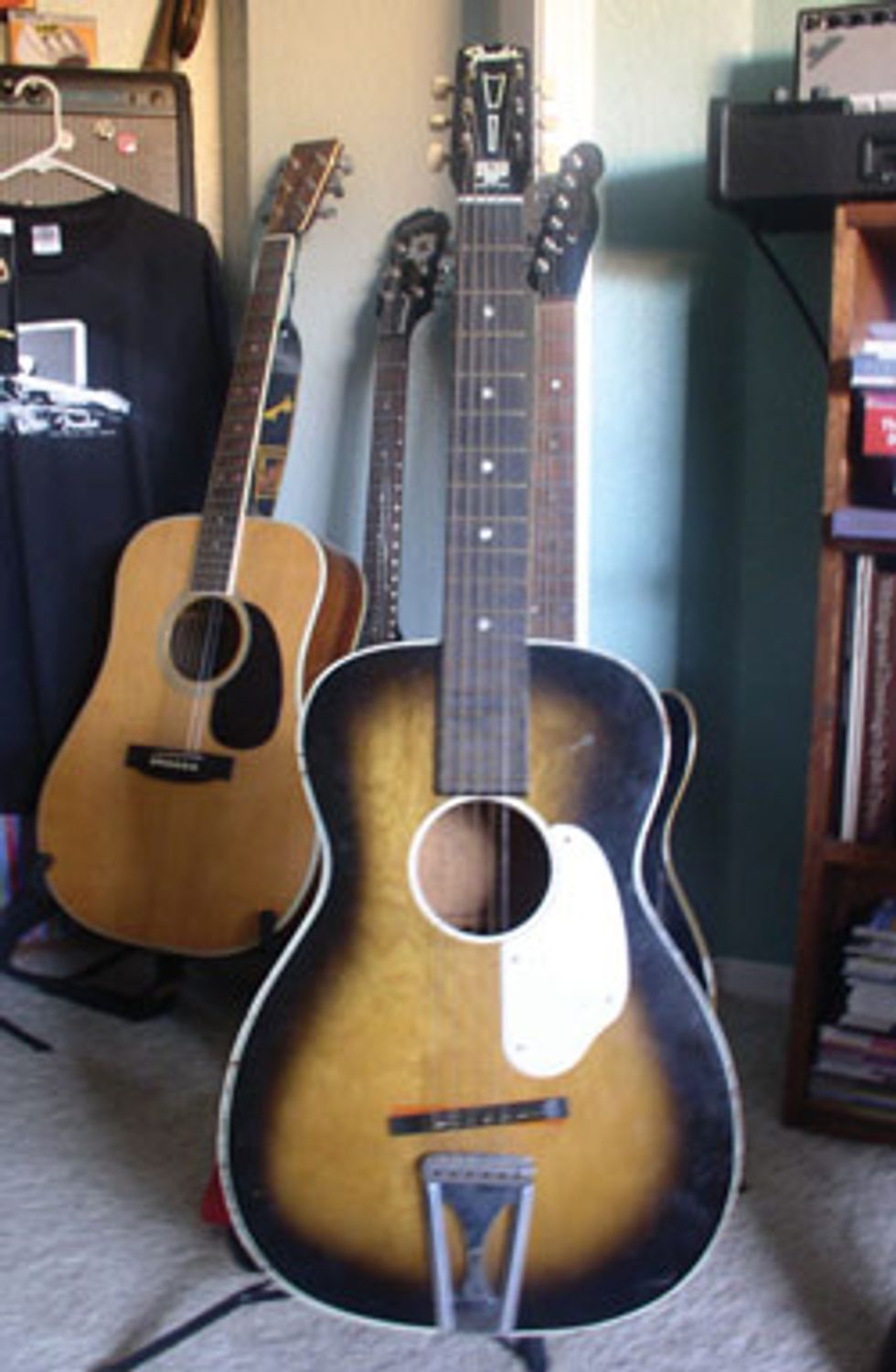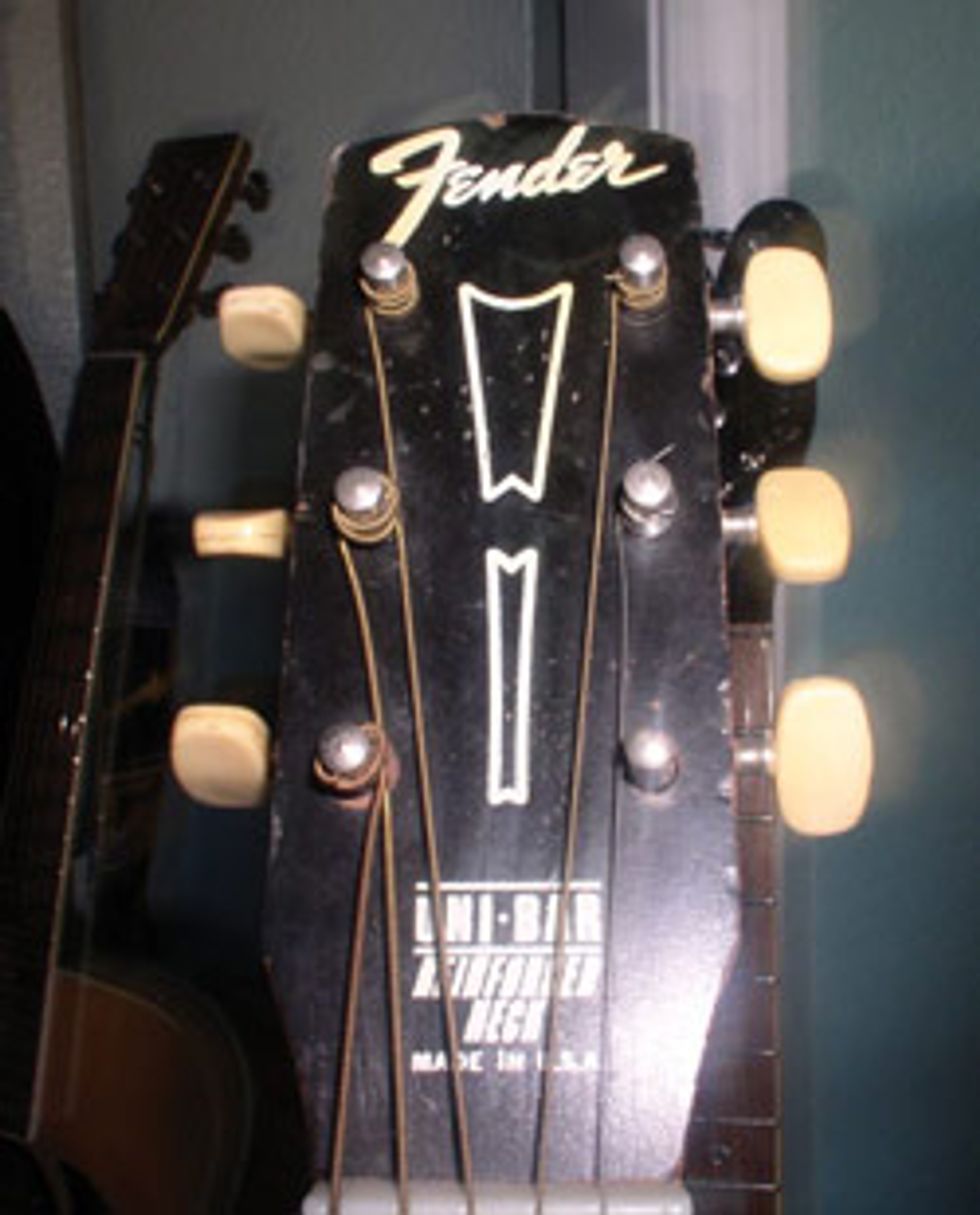 |
 |
Is there anything you can tell me about this old Fender 3/4-sized acoustic guitar? I have been around guitars for more than 40 years and have never run across one of these. There is a number stamped inside: 3235 1000. It looks like a cheap children’s guitar from the 1950s.
Thanks!
Bob in Auburn, CA
Hi Bob,
I know I’ve seen your guitar somewhere, but I just can’t put my finger on it! There seems to be a reason why you don’t run across many of these Fender guitars, and why you can’t find much information about them. Aside from current ownership/management, Fender hasn’t had much luck with acoustic guitars. Subsequently, not much information exists about their acoustic guitars, making it difficult to do any research, and it leads me to believe that Fender would be perfectly happy simply forgetting this chapter of their history. However, I uncovered some information about your guitar and the history of Fender acoustics.
Let’s not fool ourselves here—Fender is first and foremost an electric guitar and guitar amplifier company that entered the acoustic guitar market much later than many other manufacturers. To offer an acoustic alternative, a student Spanish guitar called the No. 150 started appearing in Fender’s catalogs in the late 1950s. It is unknown who built these, and the Fender trademark does not seem to appear anywhere on the guitar. By 1963, Fender was serious about offering a full acoustic guitar line and they had ex-Rickenbacker employee Roger Rossmeisel design a full series of acoustic guitars. The new Fender acoustics debuted in 1963, but they employed several electric features, including bolt-on necks, Stratocaster-style headstocks and white-colored pickguards. The first full line of Fender acoustics was produced through 1970 or early 1971.
The Concert, King, Malibu, Newporter and other 1960s-era Fender acoustics were really never well received and were considerably expensive. Fender wanted to offer a line of more affordable acoustics to compete with the increasing number of cheap imports, so they went to Harmony, who was well known for building quality budget acoustic guitars. Harmony was a large guitar manufacturer from Chicago that built guitars under the Harmony trademark, as well as over 50 other brands, making them a “house brand” in the guitar industry. In the late 1960s, Fender asked Harmony to build a line of Fenderbranded, Harmony-built acoustic guitars.
The resulting instruments became known as the first F Series, and nearly 10 different guitars were available. The numbers on the inside of your guitar indicate that it is the Model F-1000, which was the standard size flat top acoustic offered. It has an all-birch body, 12/18-fret fingerboard, metal trapeze tailpiece and a white pickguard. The headstock has a bright white Fender logo with a “Uni-Bar Reinforced Neck” inscription indicative of the steel truss rod. The F-1000 retailed for $32.95 in 1969 and the entire F Series was produced through the early 1970s. Harmony enthusiasts will note that this guitar is nearly identical to the Harmony Model H929.
Today, this is a $50–$100 guitar in excellent condition, and these F-Series acoustics can be very good players if you can find one that has a straight neck and low action. Interestingly enough, these F-Series of acoustics never appeared in Fender’s catalogs, and were only available through their price lists. It may have been Fender’s way of offering an acoustic guitar without having to jeopardize their pride by showing them in a catalog. Regardless, these guitars exist and people still play them. While it is a step above a 1950s children’s guitar, it still is a budget acoustic guitar. Now I remember! I’ve seen the same guitar mounted on the wall of my local Applebee’s as part of their décor!
Zachary R. Fjestad
Zachary is the author of the Blue Book of Acoustic Guitars, Blue Book of Electric Guitars, and the Blue Book of Guitar Amplifiers. Questions can be submitted to:
Blue Book Publications
Attn: Guitar Trash or Treasure
8009 34th Ave. S. Ste #175
Minneapolis, MN 55425
800-877-4867
bluebookinc.com
guitars@bluebookinc.com



















